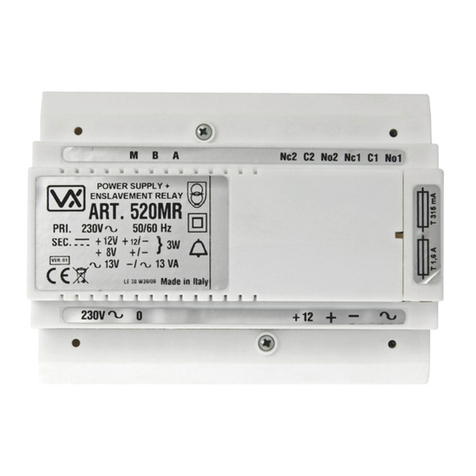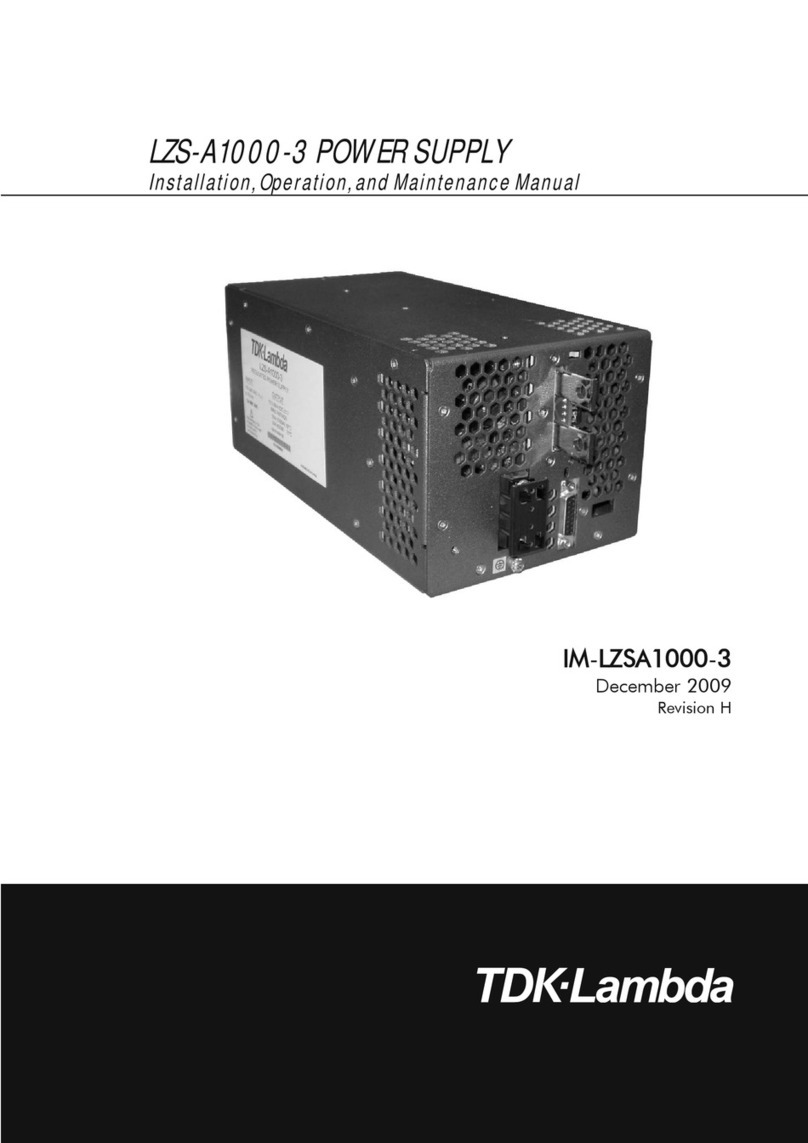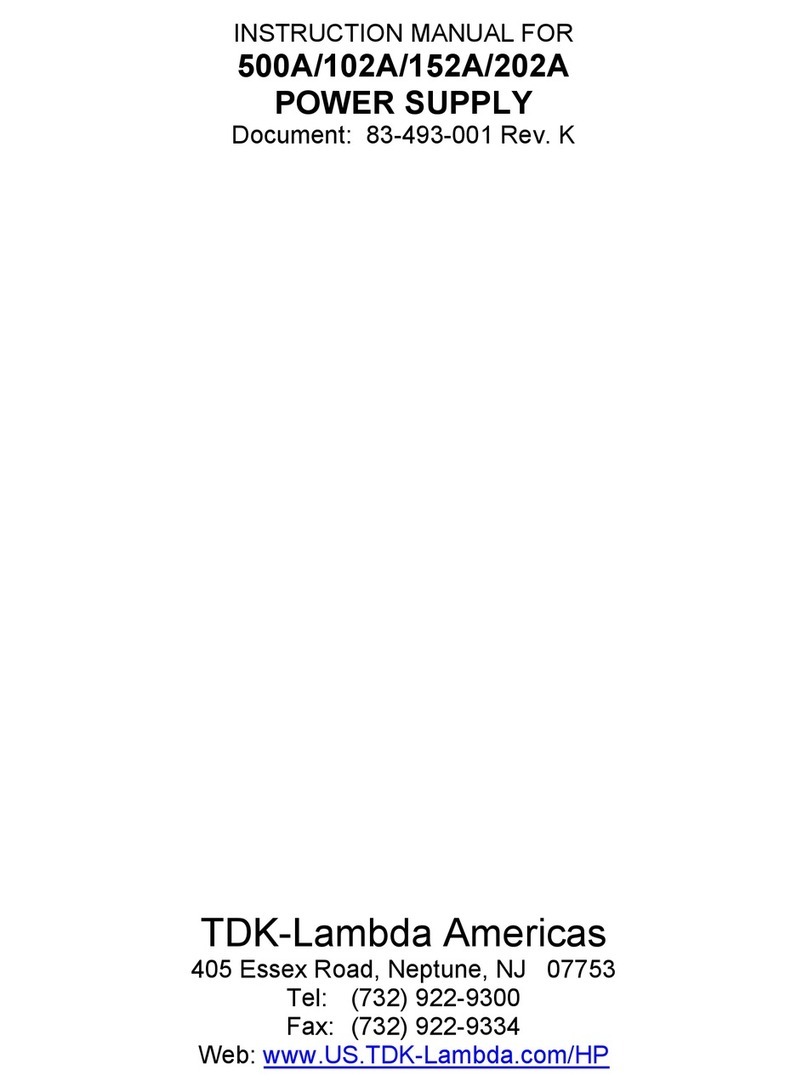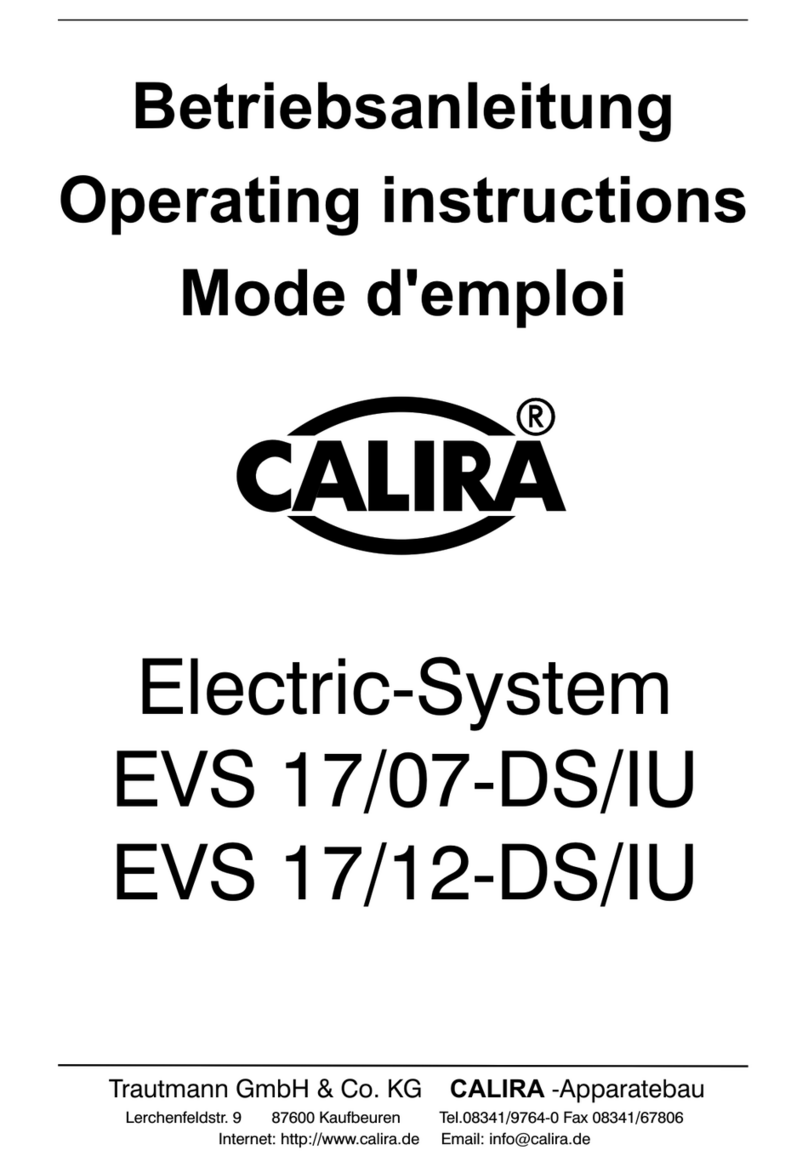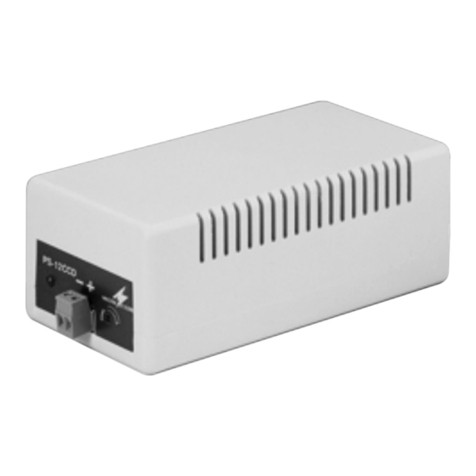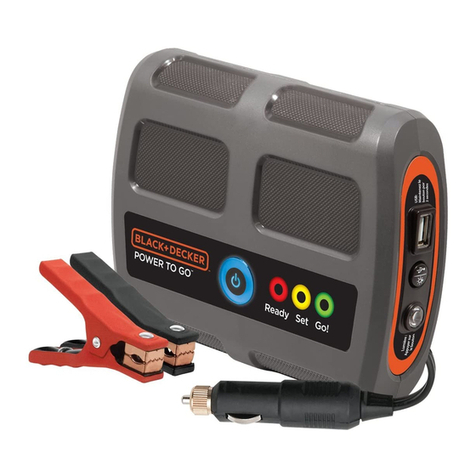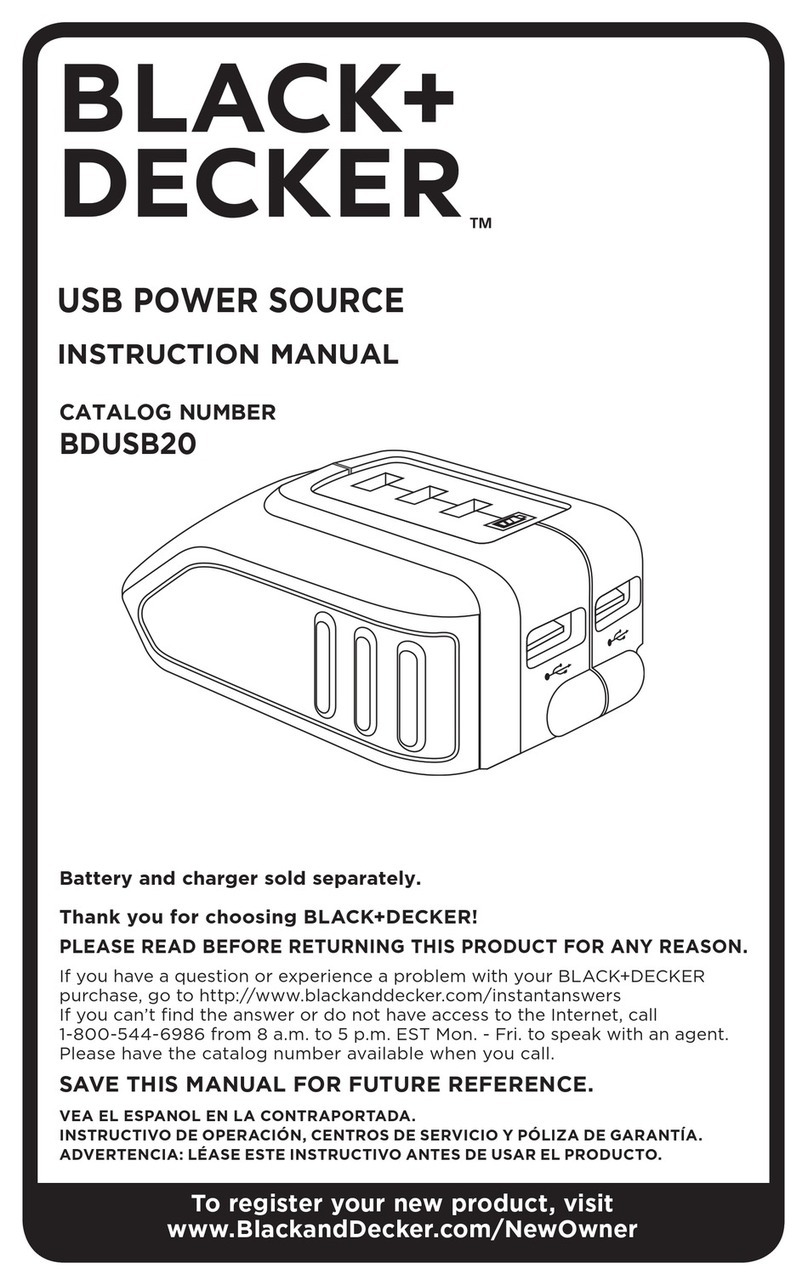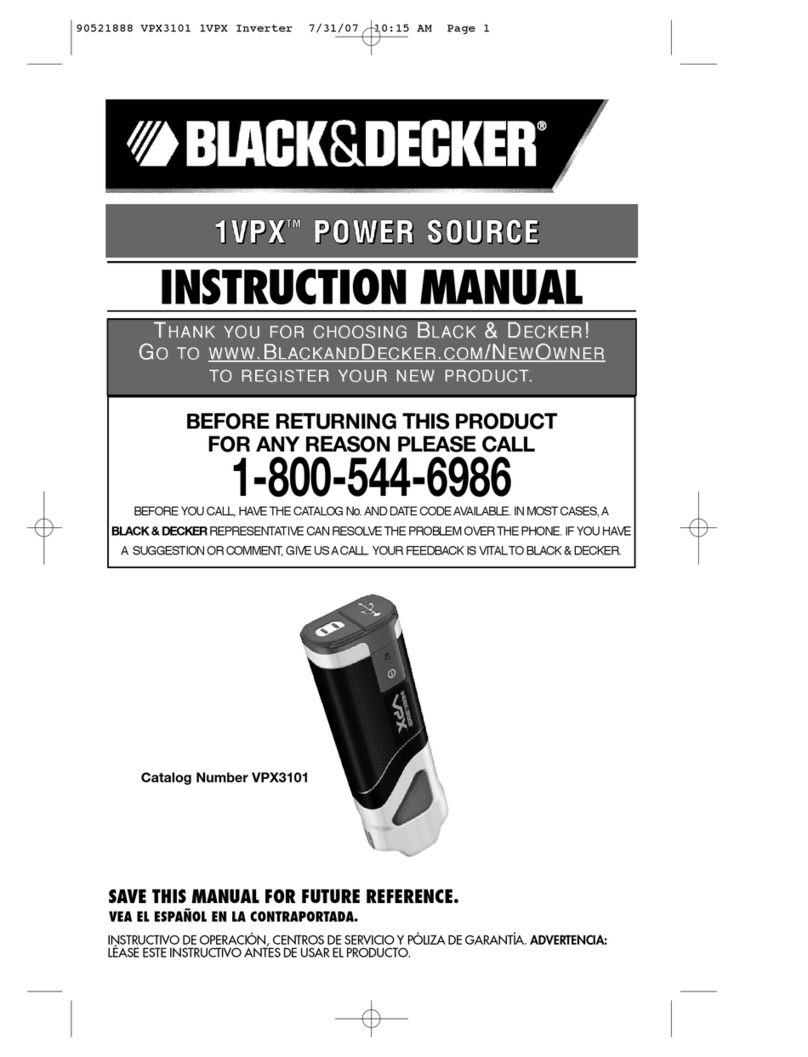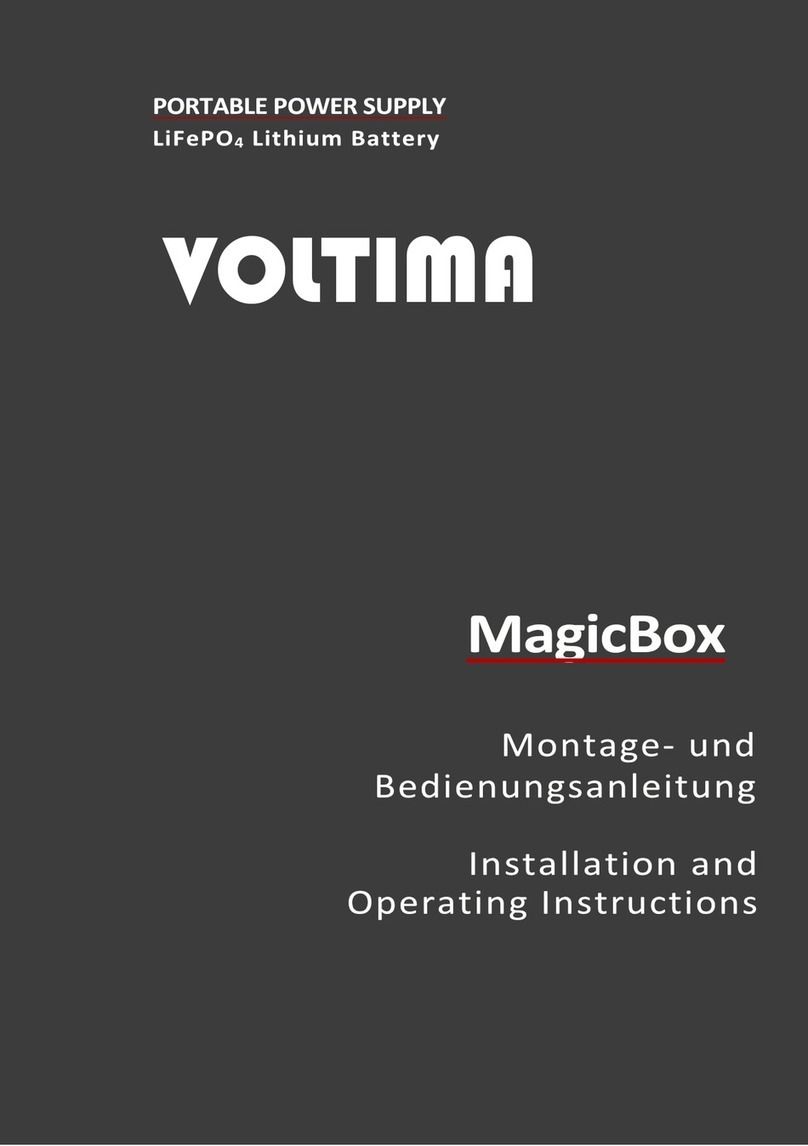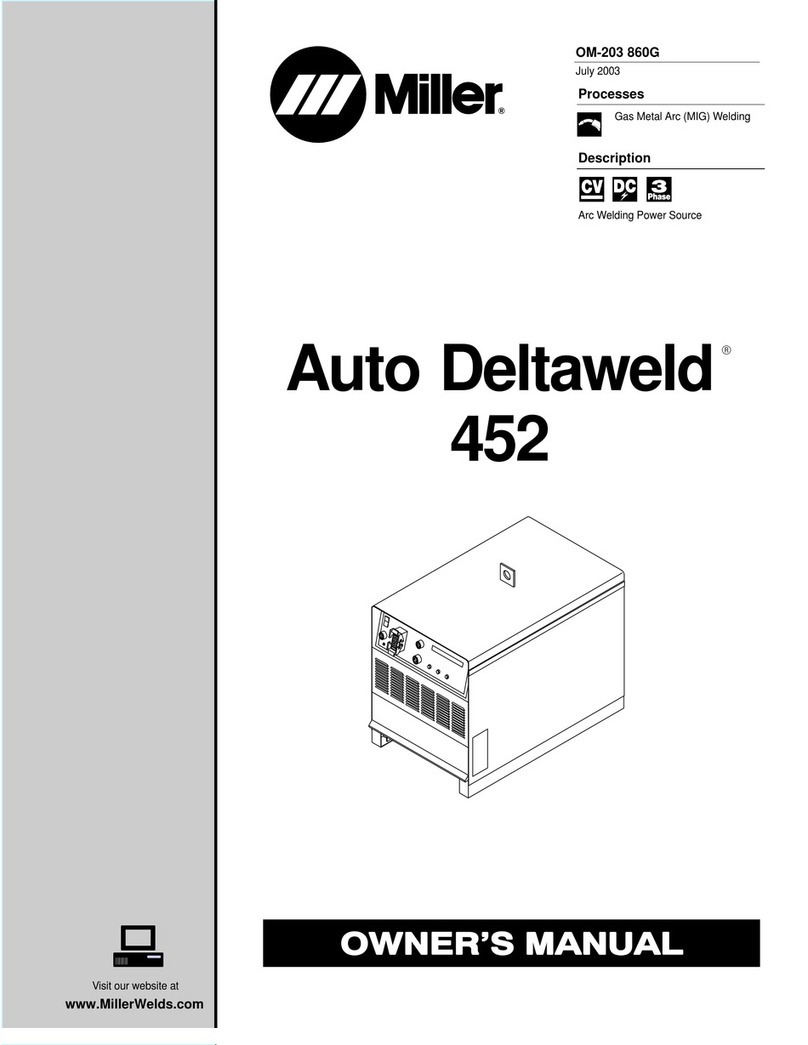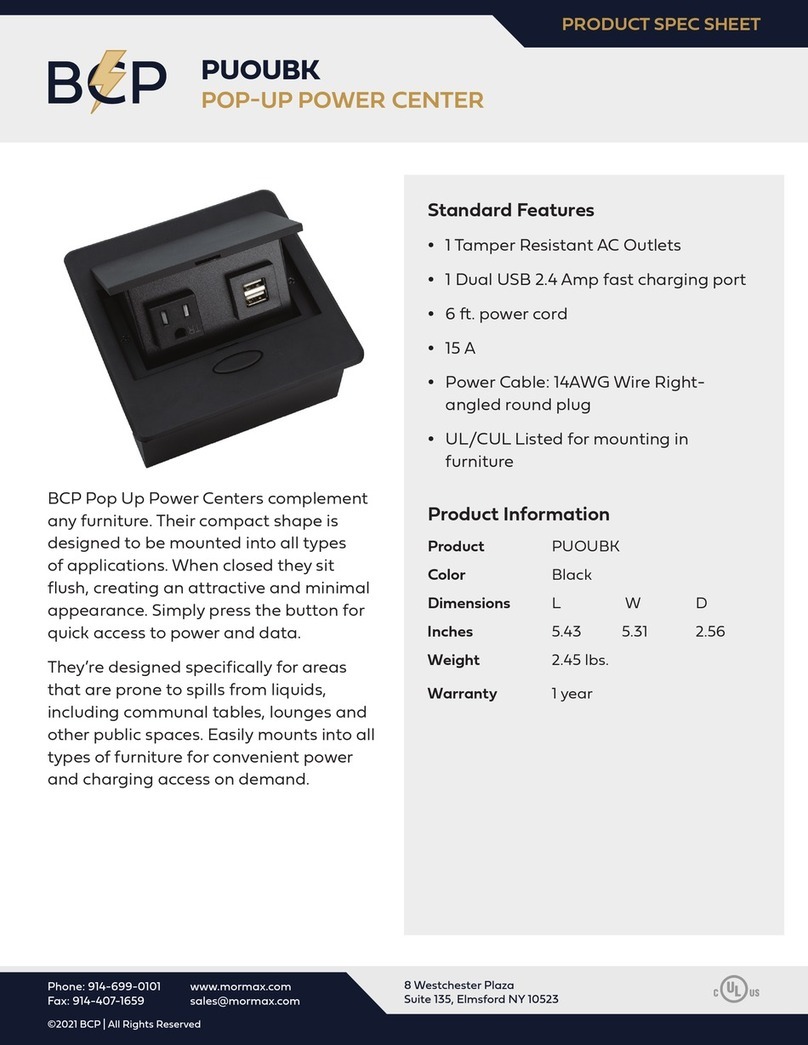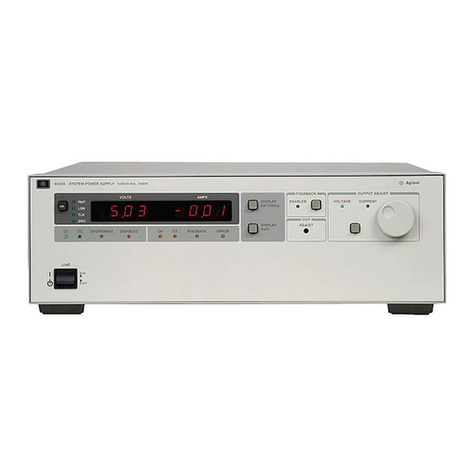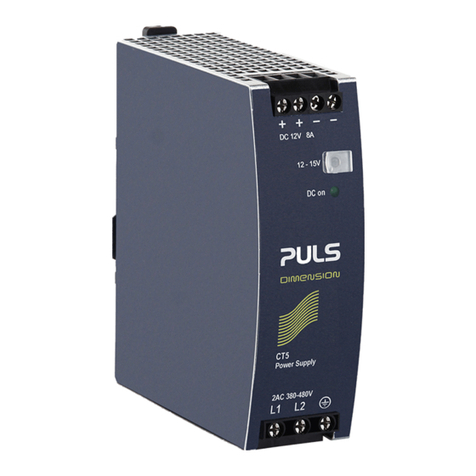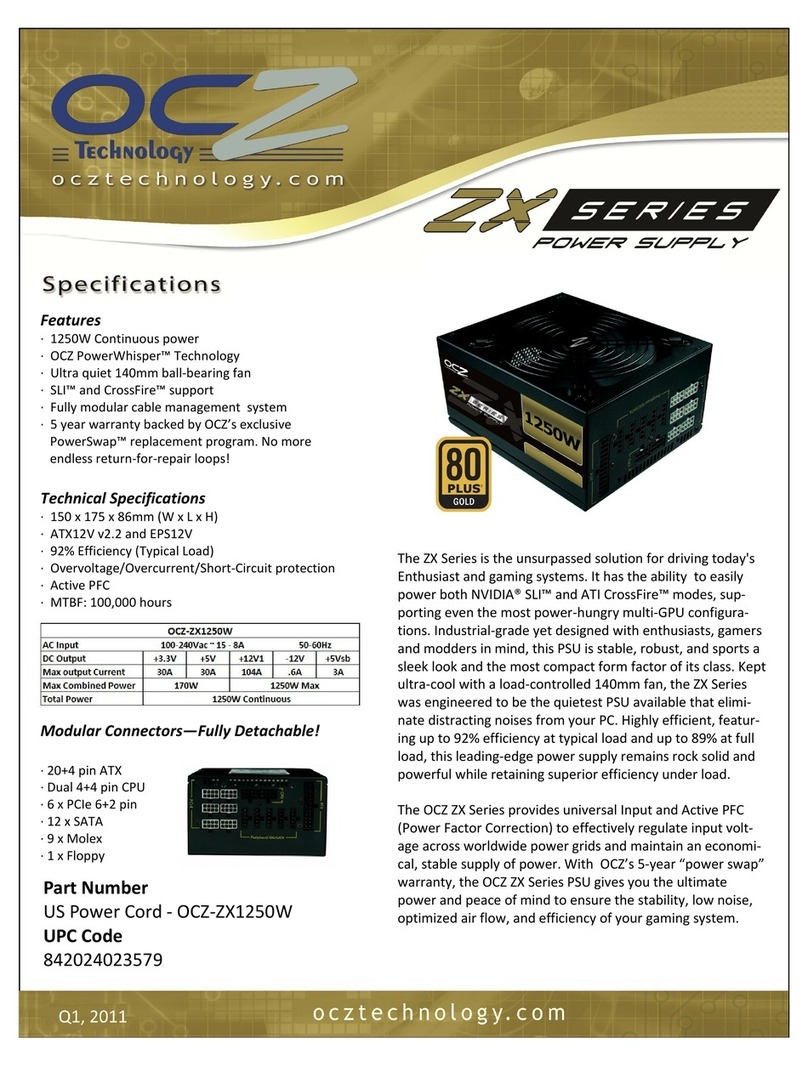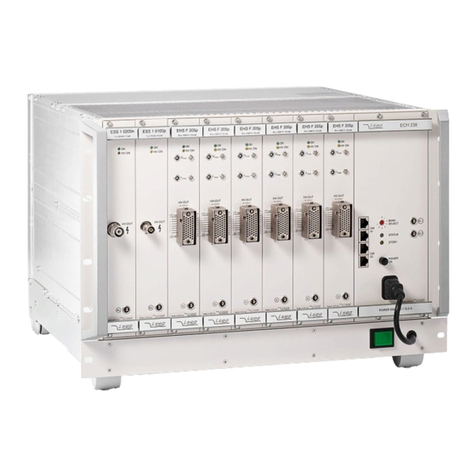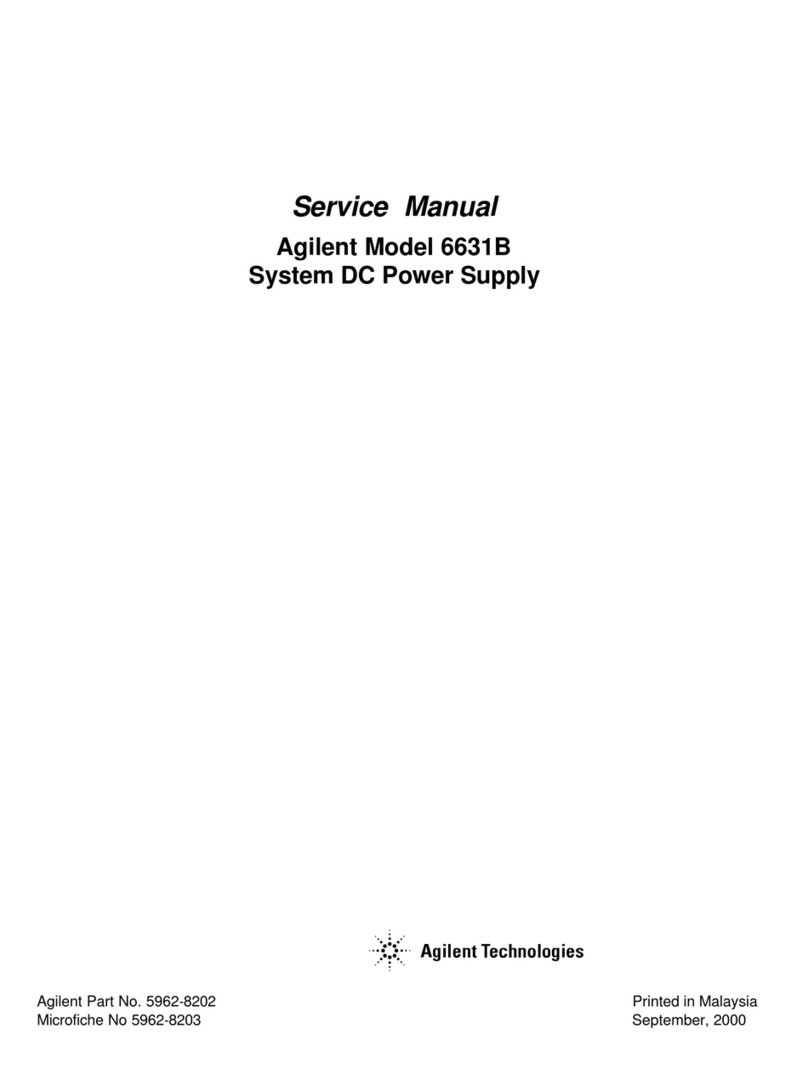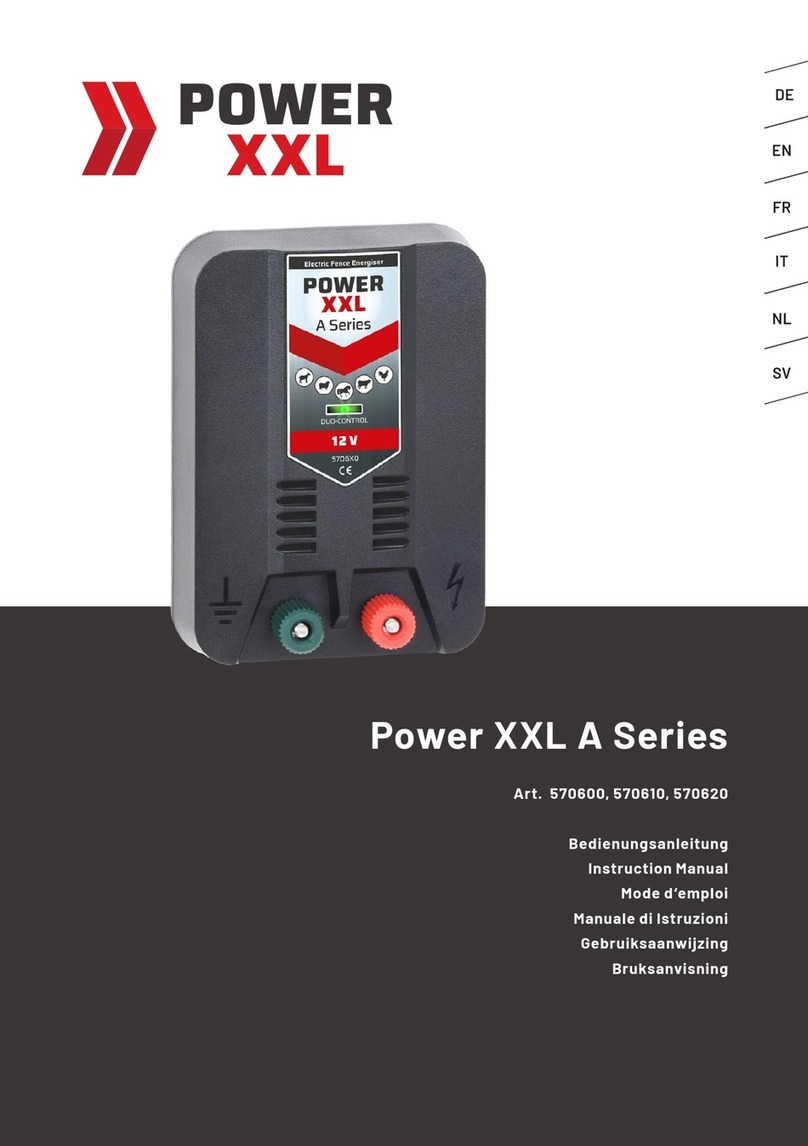
5
any equipment you intend to use in the vicinity of the battery. Review
cautionary markings on these products and on the engine.
CAUTION – TO REDUCE THE RISK OF INJURY OR PROPERTY
DAMAGE:
• NEVER ATTEMPT TO JUMP-START OR CHARGE A FROZEN BATTERY.
• Vehicles that have on-board computerized systems may be damaged if
vehicle battery is jump-started. Before jump-starting, read the vehicle’s
owner’s manual to confirm that external-starting assistance is suitable.
• Never smoke or allow a spark or flame in vicinity of vehicle battery,
engine or power station.
• Stay clear of fan blades, belts, pulleys, and other parts that can cause
injury to persons.
• Remove personal metal items such as rings, bracelets, necklaces and
watches when working with a lead acid battery. A lead acid battery
can produce a short circuit current high enough to weld a ring, or
similar metal object, to skin, causing a severe burn.
• Do not wear vinyl clothing when jump-starting a vehicle. Friction can
cause dangerous static-electrical sparks.
• Be extra careful to avoid dropping a metal tool onto the battery. It
might spark or short-circuit the battery or another electrical part and
could cause an explosion.
• Jump-start procedures should only be performed in a safe, dry, well-
ventilated area.
• Always store battery clamps when not in use. Never touch battery
clamps together. This can cause dangerous sparks, power arcing and/
or explosion.
• When using this unit close to the vehicle’s battery and engine, stand
the unit on a flat, stable surface, and be sure to keep all clamps, cords,
clothing and body parts away from moving vehicle parts.
• Never allow red and black clamps to touch each other or another
common metal conductor — this could cause damage to the unit and/
or create a sparking/explosion hazard.
a) For negative-grounded systems, connect the positive (red) clamp to
the positive ungrounded battery post and the negative (black) clamp
to the vehicle chassis or engine block away from the battery. Do not
connect the clamp to the carburetor, fuel lines or sheet-metal body
parts. Connect to a heavy gauge metal part of the frame or engine
block.
b) For positive-grounded systems, connect the negative (black) clamp
to the negative ungrounded battery post and the positive (red) clamp
to the vehicle chassis or engine block away from the battery. Do not
connect the clamp to the carburetor, fuel lines or sheet-metal body
parts. Connect to a heavy gauge metal part of the frame or engine
block.
• If the clamps are connected incorrectly with regard to polarity, the
backlit LCD screen will display the Battery Status Icon, Battery Voltage
Indicator, and the Clamp Icons. The Alarm Icon, the “+” and ”–” signs
and the Reverse Polarity Icons will flash and the unit will sound a
continuous alarm until the clamps are disconnected. Disconnect the
clamps and reconnect to battery with correct polarity.
• Always disconnect the negative (black) jumper cable first, followed by
the positive (red) jumper cable, except for positive grounded systems.
• Do not expose battery to fire or intense heat since it may explode.
Before disposing of the battery, protect exposed terminals with heavy-
duty electrical tape to prevent shorting (shorting can result in injury
or fire).
• Place this unit as far away from the battery as cables permit.
• Never allow battery acid to come in contact with this unit.
• Do not operate this unit in a closed area or restrict ventilation in any
way.
• This system is designed to be used only on vehicles with a 12 volt DC
battery system. Do not connect to a 6 volt or 24 volt battery system.
• This system is not designed to be used as a replacement for a
vehicular battery. Do not attempt to operate a vehicle that does not
have a battery installed.
• Excessive engine cranking can damage a vehicle’s starter motor. If
the engine fails to start after the recommended number of attempts,
discontinue jump-start procedures and look for other problems that
may need to be corrected.
• Do not use this jump starter on a watercraft. It is not qualified for
marine applications.
• Although this unit contains a non-spillable battery, it is recommended
that unit be kept upright during storage, use and recharging. To avoid
possible damage that may shorten the unit’s working life, protect it
from direct sunlight, direct heat and/or moisture.
SPECIFIC SAFETY INSTRUCTIONS
FOR INVERTERS
WARNING – TO REDUCE THE RISK OF ELECTRIC SHOCK:
• Do not connect to AC distribution wiring.
• Do not make any electrical connections or disconnections in areas
designated as IGNITION PROTECTED. This inverter is NOT approved for
ignition protected areas.
• Never immerse the unit in water or any other liquid, or use when wet.
WARNING – TO REDUCE THE RISK OF FIRE:
• Do not operate near flammable materials, fumes or gases.
• Do not expose to extreme heat or flames.
CAUTION – TO REDUCE THE RISK OF INJURY OR PROPERTY
DAMAGE:
• Disconnect appliance plug from inverter outlet before attempting any
repairs to the appliance.
• When an appliance plugged into this unit is used outdoors, use only
extension cords intended for use outdoors and so marked.
• Do not attempt to connect the inverter while operating your vehicle.
Not paying attention to the road may result in a serious accident.
• Always use the inverter where there is adequate ventilation.
• Always turn the inverter off when not in use.
• Keep in mind that this inverter will not operate high wattage
appliances or equipment that produce heat, such as hair dryers,
microwave ovens and toasters.
• Do not use this inverter with medical devices. It is not tested for
medical applications.
• Operate inverter only as described in this Instruction Manual.
SPECIFIC SAFETY INSTRUCTIONS
FOR THE USB PORT
• Do not insert foreign objects into the USB Port.
• Do not attach USB hubs or more than one personal electronic device
to the USB Port.
• Some household USB-powered electronics will not operate with this
unit.
SPECIFIC SAFETY INSTRUCTIONS
FOR COMPRESSORS
CAUTION – TO REDUCE THE RISK OF INJURY OR PROPERTY
DAMAGE: Never leave the compressor unattended while in use.
WARNING – BURST HAZARD: Bursting articles can cause serious
injury.
• Carefully follow instructions on articles to be inflated.
• Never exceed the recommended pressure listed in instructions
on articles to be inflated. If no pressure is given, contact article
manufacturer before inflating.
• Monitor the pressure at all times on the pressure gauge.
CAUTION – TO REDUCE THE RISK OF PROPERTY DAMAGE:
Do not operate compressor continuously for longer than approximately
10 minutes, depending on ambient temperatures, as it may overheat.
This could damage the compressor.
FIRST AID
When working with lead acid batteries, always make sure immediate
assistance is available in case of accident or emergency.
Always have protective eyewear when using this product: contact with
battery acid may cause blindness and/or severe burns. Be aware of first
aid procedures in case of accidental contact with battery acid.
Do not wear loose clothing or jewelry. They can be caught in moving parts.
Rubber gloves and substantial, non-skid footwear are recommended when
working outdoors. Wear protective hair covering to contain long hair.
Have plenty of fresh water and soap nearby in case battery acid
contacts skin.
